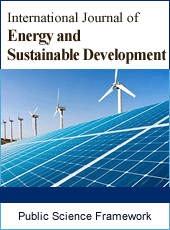International Journal of Energy and Sustainable Development
Articles Information
International Journal of Energy and Sustainable Development, Vol.1, No.1, Dec. 2016, Pub. Date: Aug. 16, 2016
Scaling Effect of the Direct Solar Hot Water Systems on Energy Efficiency
Pages: 1-5 Views: 4331 Downloads: 1310
[01]
Sowdager Moin Ahmed, Department of Mechanical Engineering, QIS Institute of Technology, Ongole, Andhra Pradesh, India.
[02]
Venkata Ramesh Mamilla, Department of Mechanical Engineering, QIS Institute of Technology, Ongole, Andhra Pradesh, India.
[03]
G. Lakshmi Narayana Rao, Department of Mechanical Engineering, QIS Institute of Technology, Ongole, Andhra Pradesh, India.
Scale formation in risers and headers solar direct water systems is problem in places where hard water is being used. In this paper the effect of scaling on energy efficiency indices such as instantaneous efficiency mass flow rate and overall heat loss coefficient are improved in case of thermosyphon system and forced circulation systems due to pressure gain in the narrow region. Scale mapping is done for the entire solar hot water system for the nature of the scale growth. It is seen in the thermosiphon system the mass flow rate decreased by scaling, this affects increases the energy efficiency more than that of the heat transfer rate. The scaling effect is more predominant in thermosyphon system than the forced circulation system. The difference between mass flow rate in scale and unscaled conditions is less in forced circulation but much higher in thermosyphon system.
Scaling Effect, Solar Hot Water Systems, Energy Efficiency
[01]
Zhen Wu, Lorraine F. Francis and Jane H. Davidson, Scale formation on polypropylene and copper tubes in mildly supersaturated tap water, Solar Energy, 2009, pp. 636–645.
[02]
Derek Baker and Gary Vliet, Designing Solar Hot Water Systems for Scaling Environments, Solar Energy (ASME), Vol. 123, Feb. 2001, pp. 43-47.
[03]
U. C. Arunachala, M. Siddhartha Bhatt and L. K. Sreepathi, Scaling Effect of Direct Solar Hot Water Systems on Energy Efficiency, Solar Energy (ASME), Vol. 132, November 2010.
[04]
Duffie J. A. and Beckman W.A., Solar Engineering of Thermal Processes, 2nd ed., Wiley Interscience, New York, 1991.
[05]
G. L. Morrison and B. J. Ranatunga, Thermosyphon circulation in solar collectors, Solar energy, Vol. 24, pp 191 -198, 1980.
[06]
Avvannavar, S. M., M. Mani, and N. Kumar. 2008. “An Integrated Assessment of the Suitability of Domestic Solar Still as a Viable Safe Water Technology for India.” International Journal of Environmental Engineering and Management 7 (6): 667–685.
[07]
Baker, D., and G. Vliet. 2001. “Designing Solar Hot Water Systems for Scaling Environments.” Solar Energy (ASME) 123 (1): 43–47.
[08]
Belessiotis, V., and E. Mathioulakis. 2002. “Analytical Approach of Thermosyphon Solar Domestic Hot Water System Performance”. Solar Energy 72 (4): 307–315.
[09]
D. J. Close, The performance of solar water heaters with natural circulation, Solar Energy, No.6, 1962, pp. 33–40.
[10]
Simplified Residential Solar Hot Water System Calculator, Florida Solar Energy Center (2007).

ISSN Print: Pending
ISSN Online: Pending
Current Issue:
Vol. 4, Issue 2, June Submit a Manuscript Join Editorial Board Join Reviewer Team
ISSN Online: Pending
Current Issue:
Vol. 4, Issue 2, June Submit a Manuscript Join Editorial Board Join Reviewer Team
| About This Journal |
| All Issues |
| Open Access |
| Indexing |
| Payment Information |
| Author Guidelines |
| Review Process |
| Publication Ethics |
| Editorial Board |
| Peer Reviewers |


